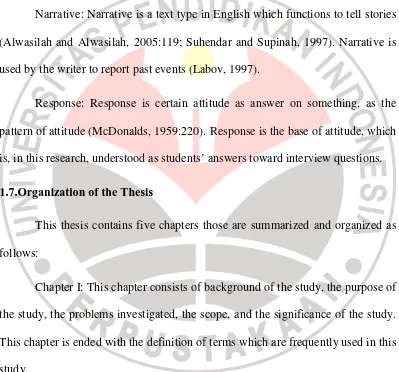CHAPTER I
INTRODUCTION
1.1.Background
This research was performed to investigate the impact of peer feedback toward the students’ narrative writing, and the students’ responses toward peer feedback activities in the ESL writing classroom. Although many researchers noted that peer feedback positively influences students’ writing skills, peer feedback was originally used in first language writing classroom during 1970s (Hyland and Hyland, 2006:1). This means that peer feedback was an approach formulated to apply in L1 context and its effectiveness in L2, especially ESL, is still questioned and debated.
During 2000s, researchers (e.g., Zeng, 2006; Kamimura, 2006; Jiao, 2007; and Hirose, 2009) had been interested in peer feedback effectiveness; therefore they investigated the impact of peer feedback on the students’ writing in ESL classroom. In conclusion, they revealed that peer feedback offers many ways to improve students’ writing.
understand) that even professional writers do not just write a one-shot draft to make their message clear (Emilia, 2010:163). Therefore, when a teacher considers using process oriented in writing instruction, the students may have more opportunities to learn how to write in a real situation.
Peer feedback is an approach where social dimension is created in the writing classroom, based on assumption that writing is a social process (Hyland, 2005:198). Even, language learning is said as a social process and knowledge is transmitted in social contexts, through relationships, like those of parent and child, or teacher and pupil, or classmates (Halliday, in Emilia, 2010:36). Furthermore, learning as social process acquired through social interaction shapes the learner’s acquisition of skills (Olivera and Strauss 2004, as cited in al-Qurashi, 2009:57).
Since writing is a social process, the students should be placed as members of classroom society. Placing students in the social situation like this gives them opportunities to give and to receive meaningful inputs from one to another. This suggests that narrowing the social dimension into ESL writing classroom emerges opportunities to negotiate their strength to improve other and their weakness to be strengthened. In other words, it is reasonable to consider peer feedback as an alternative in ESL writing classroom
although according to Clark (2003) the development achieved by the students is seemed superficial. Nevertheless, peer feedback is shown as an alternative applicable to improve students’ writing (skill and text) under certain condition (Hyland and Hyland, 2006).
As already mentioned, this research also aims to investigate students’ responses toward peer feedback. Related to this issue, Rollinson (2005) mentions that the students responded peer feedback activities as beneficial. In line with this, Jacobs et al. (1998) stated that they believe that students usually welcome peer feedback as one type of feedback in writing classroom. However, students’ responses toward peer feedback activities are also still questioned. Hong (2006), for example, revealed a contradictive result with Rollinson (2005) and Jacobs et al. (1998), that is, students devalued peer feedback in ESL writing classroom with various reasons.
Researches indicated that peer feedback has certain impact on students’ writing, and based on the background above, this research was performed to investigate the impact of peer feedback on the students’ narrative writing and students’ responses toward peer feedback activity in ESL writing classroom.
1.2.Purpose of the Study
1.3.Research Question
In line with the purpose of the study, this study attempted to address the following questions:
1.3.1. To what extent does the students’ narrative writing develops through peer feedback?
1.3.2. What are the students’ responses toward peer feedback activities in ESL writing classroom?
1.4.Scope of the Study
This research was conducted in a limited numbers of students in an undergraduate ESL classroom, which was taught writing and developing narrative writing through peer feedback. And as this research is intentionally designed as qualitative case study, this research result is not generalized to broader context.
1.5.Significance of the Study
1.6.Definition of Terms
Peer Feedback: Peer feedback is simply defined as feedback given by peer (Zeng, 2006). Peer feedback is a range of activities where social environment is created in the classroom to encourage students to share, to comment, to respond, to correct, and to negotiate ideas (Spear, 1988; Williams, 2005; Hyland, 2005).
Narrative: Narrative is a text type in English which functions to tell stories (Alwasilah and Alwasilah, 2005:119; Suhendar and Supinah, 1997). Narrative is used by the writer to report past events (Labov, 1997).
Response: Response is certain attitude as answer on something, as the pattern of attitude (McDonalds, 1959:220). Response is the base of attitude, which is, in this research, understood as students’ answers toward interview questions.
1.7.Organization of the Thesis
This thesis contains five chapters those are summarized and organized as follows:
Chapter I: This chapter consists of background of the study, the purpose of the study, the problems investigated, the scope, and the significance of the study. This chapter is ended with the definition of terms which are frequently used in this study.
Chapter III: This chapter consists of the methodology of the research which covers research design, techniques of data collection, and techniques of data analysis.
Chapter IV: In this chapter, the findings of the research are discussed. The discussion is divided into two big parts: students’ narrative writing development and students’ responses toward peer feedback. Each category is discussed in subsequent order according to the type of development achieved by the students.
